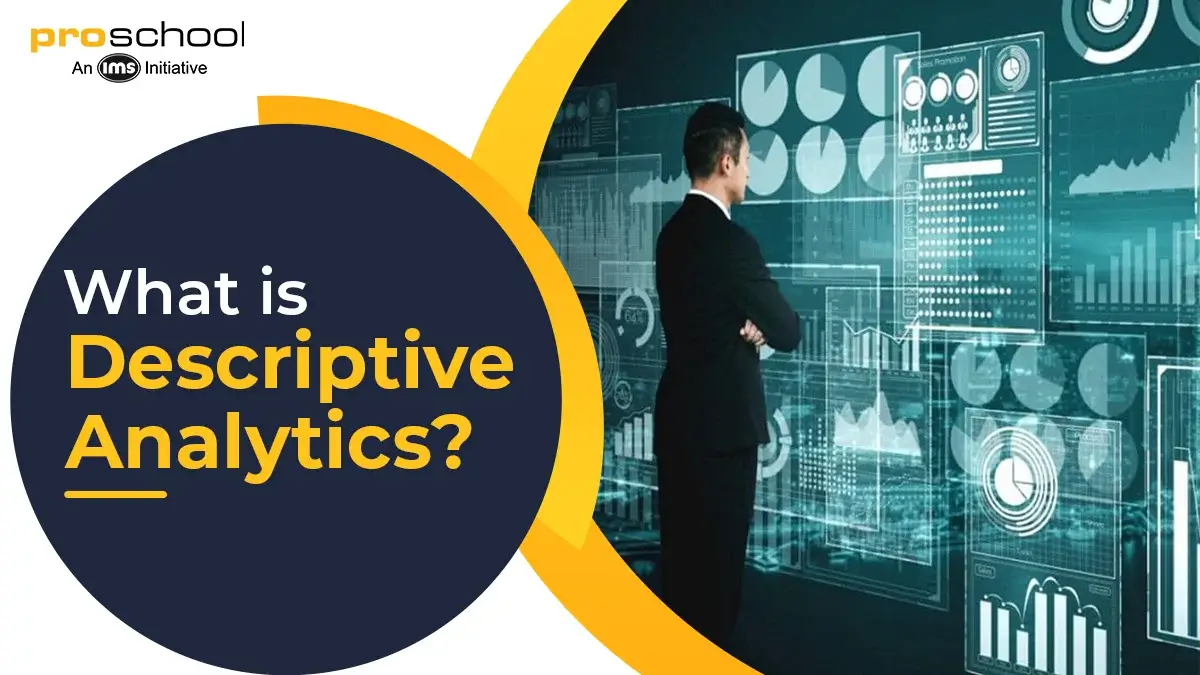What Is Descriptive Analytics : A Simple Guide

Here's What We've Covered!
Imagine trying to solve a puzzle without seeing the full picture. That’s what decision-making in business looks like without data. This is where descriptive analytics comes in — the first and most crucial step in understanding what has happened in your business, and why.
Descriptive analytics refers to the practice of analyzing historical data to identify trends, patterns, and outcomes. It’s not about predicting the future or prescribing actions — it’s about making sense of what already happened. Think of it as the rearview mirror that helps you understand where your business has been.
In today’s data-driven world, every professional — from marketing managers to healthcare consultants — relies on descriptive analytics to answer the question: “What happened?”
The good news? You don’t need a tech background to learn it. Whether you’re from a commerce background, creative field, or just starting out, descriptive analytics is a skill that’s accessible, practical, and in demand across industries.
If you’re new to analytics or looking to upskill, this beginner’s guide will break it down step-by-step — with real-life examples, practical tools, and expert tips to get you started confidently.
What Is Descriptive Analytics?
At its core, descriptive analytics is about making sense of past data. It’s the process of collecting, organizing, and analyzing historical information to understand what has already occurred in a business or system.
A Simple, Jargon-Free Explanation
Think of descriptive analytics like a report card. It doesn’t predict your future grades or tell you how to improve — it simply summarizes your past performance. In business, this means taking raw data and turning it into clear summaries, charts, and trends that help you answer questions like:
- How much did we sell last month?
- Which product had the most returns?
- How did our customer engagement change over time?
The power of descriptive analytics lies in its ability to convert large volumes of data into actionable insights — all without needing complex algorithms or coding knowledge.
Common Business Examples
To make this real, let’s look at some everyday use cases:
- Monthly sales reports: Compare last month’s sales with the previous month or the same month last year.
- Customer behavior summaries: Identify what time of year customers spend more, or which products they buy most.
- Churn analysis: Understand how many users left your platform and when — helping identify potential service issues.
Visual Examples That Make It Click
Let’s say a retail company tracks its weekly revenue using Excel dashboards. They can use:
- Bar charts to compare sales across stores
- Pie charts to show which product categories earn the most
- Line graphs to spot rising or falling trends over months
These are not just pretty visuals — they are critical tools in decision-making. And you can create them using basic tools you probably already know, like Excel or Google Sheets.
Also Read- Business Analytics vs Data Science: Know The Exact Difference
Key Functions of Descriptive Analytics
Descriptive analytics focuses on converting raw data into meaningful summaries. Here are the primary functions it performs in any business context:
- Data Summarization: It aggregates large datasets to provide totals, averages, percentages, and frequencies that are easy to interpret.
- Reporting: It creates structured outputs like tables, charts, and dashboards to show business performance across different time frames, products, or regions.
- Trend Identification: It visualizes trends over time, such as seasonality in sales or shifts in customer behavior.
- Segmentation: It helps group data by customer types, geographies, or performance categories to uncover useful insights.
- Pattern Recognition: It detects repetitive events or anomalies — like monthly spikes in demand or dips in user engagement.
By focusing on these tasks, descriptive analytics answers the foundational business question: “What happened?” This insight is crucial before moving on to predictive or prescriptive strategies.
Also Read- Want a job in Business Analytics? Read top 6 job profiles & salaries
Why Businesses Rely on Descriptive Analytics
In nearly every industry today, data is being generated at a massive scale. But raw data by itself doesn’t help anyone. That’s why businesses rely on descriptive analytics — to convert that information into clear, meaningful insights.
This type of analytics helps companies answer questions like:
- What happened last quarter?
- Which product categories performed best?
- Where did we lose customers?
By identifying trends, patterns, and performance indicators, descriptive analytics becomes a critical starting point for decision-making.
Industry-wise Use Cases
To understand how powerful descriptive analytics is, let’s look at a few real-world examples across industries:
E-commerce
Online retail platforms use descriptive analytics to track sales performance across products, seasons, and regions. They generate dashboards showing:
- Daily or weekly sales numbers
- Cart abandonment rates
- Most-viewed products
This helps them identify what’s working and what needs improvement.
Healthcare
Hospitals and clinics use descriptive analytics to monitor patient data and treatment outcomes. For instance:
- How many patients were admitted for a specific illness in the last 6 months
- Recovery rates by department
- Appointment no-show rates
Such summaries help improve patient care and optimize hospital resources.
Finance
Banks and financial institutions rely on descriptive analytics for expense tracking and fraud detection. Common applications include:
- Monthly expense summaries by customer segment
- Analysis of late payments or default rates
- Reviewing historical transaction data for anomalies
A Foundation for Deeper Analytics
The main reason descriptive analytics is essential is because it helps businesses understand “what happened” before they explore “why” it happened (diagnostic analytics) or “what to do next” (prescriptive analytics). In other words, it sets the foundation for all other types of data-driven decision-making.
Descriptive analytics is the first module in Proschool’s hands-on Business Analytics program. Learn with real business cases and practical tools.
Also Read- The Hidden Role of Analytics in Digital Marketing Strategies
Descriptive vs. Predictive vs. Prescriptive: Know the Analytics Types
To truly understand where this fits into the world of data, it’s important to see how it compares with other major types of analytics — predictive and prescriptive. Each plays a unique role in helping businesses make smarter decisions.
The Three Pillars of Data Analytics
Let’s break them down in simple terms:
- Descriptive Analytics: Focuses on what has already happened
- Predictive Analytics: Tries to forecast what is likely to happen
- Prescriptive Analytics: Recommends what action should be taken next
Understanding these types ensures you apply the right technique at the right time — especially when building a career in analytics.
When Should You Use Descriptive Analytics?
Descriptive analytics is ideal when you want to:
- Summarize historical data
- Track performance over time
- Identify patterns and trends
- Understand customer or user behavior
It is often the first step in any analysis workflow. You can’t predict the future or make decisions unless you clearly understand the past — and that’s exactly what it provides.
Quick Comparison Table
| Analytics Type | What It Answers | Example Use Case |
| Descriptive | What happened? | Monthly sales report |
| Predictive | What could happen? | Forecasting customer churn |
| Prescriptive | What should we do? | Recommending inventory reorder levels |
Each layer builds on the one before it. That’s why mastering descriptive analytics is crucial before diving into more advanced techniques.
Want to learn all three types of analytics step-by-step? Explore how descriptive analytics fits into the full Business Analytics learning path at Proschool.
Tools & Techniques for Descriptive Analytics
You don’t need to be a coder or data scientist to get started with descriptive analytics. Thanks to easy-to-use tools and intuitive techniques, even beginners can start analyzing data within days.
The Big 3 Tools You Should Know
These tools are the most widely used in the business world and are core components of Proschool’s Business Analytics training:
-
Microsoft Excel
Still the most accessible analytics tool. Excel allows you to calculate averages, create pivot tables, and build bar or pie charts with just a few clicks.
-
Power BI
A powerful dashboarding tool from Microsoft. Power BI connects to different data sources and builds interactive visuals and reports used by companies for business intelligence.
-
Tableau
Tableau is popular for its drag-and-drop interface and beautiful visuals. It helps users build dashboards that uncover insights from large datasets without writing code.
Top Programming languages You Should Know
-
SQL (Structured Query Language)
While not a visualization tool, SQL is essential for pulling descriptive data directly from databases — widely used by analysts in finance, healthcare, and tech.
-
Python (with Pandas & Matplotlib)
For those who eventually want to automate reporting or handle very large datasets, Python is the go-to language. Pandas is great for summarizing data, and Matplotlib/Seaborn for visualizing it.
-
R (with ggplot2)
Another statistical language used for deeper analysis and reporting, especially in academic and research-heavy environments.
These tools are beginner-friendly but also scalable — so as your skills grow, they’ll grow with you.
Common Descriptive Analytics Techniques
Once you’re using the right tools, here are some basic techniques you’ll apply:
-
Data Aggregation
Combine data from different sources or time periods to produce meaningful summaries (e.g., total monthly sales).
-
Frequency Distribution
Helps identify how often something occurs in a dataset. Useful for customer segmentation or product popularity.
-
Summary Statistics
Use metrics like mean, median, mode, and standard deviation to quickly understand overall performance or variation.
These techniques are the building blocks of almost every analytics task — and they don’t require coding.
Want to learn how to use Excel, Tableau, and Power BI hands-on? Proschool’s Business Analytics Course trains you on all these tools with real business data. Enroll now to build job-ready skills from day one.
What Are the Job Roles You Can Get Into After Learning Descriptive Analytics?
Learning descriptive analytics opens the door to many roles across industries. Since understanding past data is essential for all businesses, professionals skilled in this are in high demand.
Common Job Roles
-
Data Analyst
Focuses on gathering, summarizing, and visualizing data to support business decisions.
-
Business Analyst
Uses descriptive analytics to identify trends, understand customer behavior, and provide actionable insights.
-
Reporting Analyst
Creates detailed reports and dashboards for management to monitor key business metrics.
-
Operations Analyst
Analyzes operational data to improve efficiency and track performance.
-
Marketing Analyst
Studies campaign data, customer segmentation, and sales trends to optimize marketing strategies.
-
Financial Analyst
Tracks expenses, revenue patterns, and financial performance.
Industries Hiring Descriptive Analytics Professionals
- E-commerce & Retail: Analyzing sales, customer behavior, and inventory trends.
- Healthcare: Patient data analysis and performance reporting.
- Finance & Banking: Expense tracking, fraud analysis, and customer insights.
- Marketing & Advertising: Campaign performance and audience segmentation.
Salary Expectations (Approximate, India-based)
| Level | Average Salary (INR per annum) |
| Fresher | ₹3,00,000 – ₹5,00,000 |
| Mid-Level | ₹6,00,000 – ₹10,00,000 |
| Senior-Level | ₹12,00,000 and above |
These numbers can vary based on location, industry, and company size but offer a general guideline.
Thousands of learners started their analytics careers by mastering descriptive analytics at Proschool. Join them and kickstart your analytics career today!
Challenges Beginners Face — And How Proschool Helps You Overcome Them
Starting out can feel overwhelming, but knowing the common challenges can help you prepare and overcome them effectively.
Common Challenges
- Messy Data
Real-world data is often incomplete or inconsistent. Cleaning data is essential before you can analyze it meaningfully. - Creating Effective Visualizations
Turning raw numbers into clear charts and dashboards can be tricky without the right guidance. - Interpreting Results Correctly
Understanding what the data actually means — beyond just the numbers — requires practice and real-world examples.
How Proschool Supports You
- Data Cleaning Techniques
Proschool teaches practical methods to clean and prepare data for accurate analysis. - Hands-on Visualization Training
Learn to build impactful charts and dashboards using tools like Excel, Tableau, and Power BI. - Case-Based Learning
Work with real datasets and business scenarios to sharpen your interpretation skills. - Mentorship and Doubt-Clearing Sessions
You’re never alone — expert mentors guide you and answer your questions throughout your learning journey.
Learning analytics alone? Don’t. Proschool’s mentors guide you every step of the way.
Conclusion: Descriptive Analytics Is Your First Step Into Data
Descriptive analytics is the foundation of all data-driven decision-making. By understanding what happened in the past, businesses can make informed choices and set the stage for future growth.
For beginners, its the perfect starting point — it’s approachable, practical, and essential. Don’t let fear of data hold you back. With the right guidance, anyone can learn to analyze and visualize data effectively.
Ready to start your data journey? Unlock your potential and open doors to exciting career opportunities by mastering descriptive analytics.
Start your data journey today. Enroll in IMS Proschool’s Business Analytics Course and build the skills that employers value.
FAQs
1. What is descriptive analytics with an example?
Descriptive analytics is the process of analyzing past data to understand what has happened in a business. For example, a company reviewing its monthly sales report to identify top-selling products is using descriptive analytics.
2. Is descriptive analytics easy to learn for beginners?
Yes, descriptive analytics is one of the easiest types of data analytics to learn. It doesn’t require coding and focuses on tools like Excel and Tableau, which are beginner-friendly.
3. Which tools are used in descriptive analytics?
The most commonly used tools include Microsoft Excel, Power BI, and Tableau. Advanced users may also use SQL, Python, or Google Looker Studio for data summarization and visualization.
4. What jobs can I get if I learn descriptive analytics?
Some of the job roles include Data Analyst, Business Analyst, Reporting Analyst, Marketing Analyst, and Financial Analyst. These roles are in demand across industries like e-commerce, healthcare, finance, and marketing.
5. Do I need coding to learn descriptive analytics?
No, you don’t need coding to get started. Descriptive analytics focuses on tools and techniques that don’t require programming knowledge. However, learning some SQL or Python later can enhance your skills.
6. What’s the difference between descriptive and predictive analytics?
Descriptive analytics tells you what happened in the past, while predictive analytics forecasts what might happen in the future. Descriptive is the first step before diving into more advanced analytics types.
7. Can I learn descriptive analytics online?
Absolutely! There are several online courses, including IMS Proschool’s Business Analytics Course, that offer structured, beginner-friendly training with real-world projects.
Resent Post
>
Emerging commerce career options in India (2026): From CA to Data Analyst
>
ACCA Opportunities You Didn’t Know About – Think Beyond Audit!
>
Which Courses After 12th Commerce With High Salary Are in Demand Worldwide?
>
How to Find ACCA Jobs Online After Qualifying: Real Portals, Tips & Career Guidance
>
Financial Modelling Classes in Hyderabad: Your Guide to the Best Institutes
Follow Us For All Updates!



